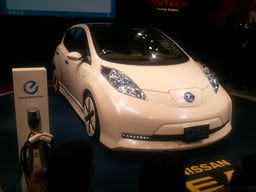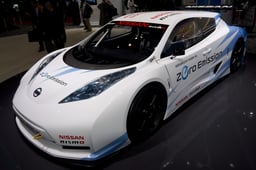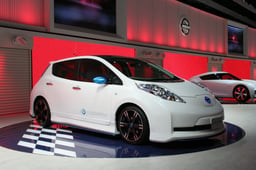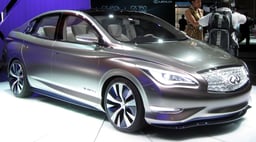Nissan Leaf
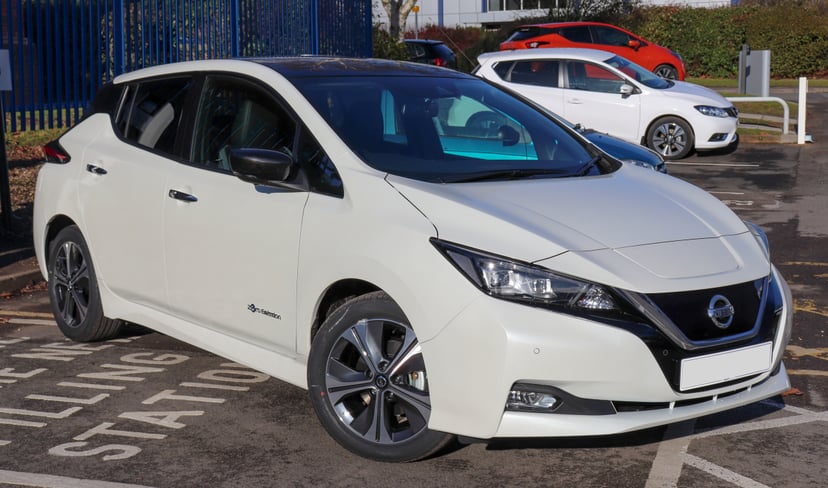
Nissan Leaf

| Nissan Leaf | |
|---|---|
| Overview | |
| Manufacturer | Nissan |
| Production | 2010–present |
| Body and chassis | |
| Class | Compact car / Small family car (C) |
| Body style | 5-door hatchback |
| Layout | Front-motor, front-wheel-drive |
| Nissan Leaf (ZE0) | |
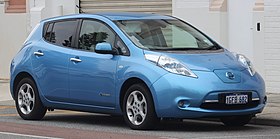 | |
| Overview | |
| Manufacturer | Nissan |
| Also called | Venucia e30 (China; 2014–2018) |
| Production | 2010–2017 |
| Assembly | Japan: Oppama Plant, Yokosuka, Kanagawa, Japan United States: Smyrna, Tennessee United Kingdom: Sunderland (NMUK) |
| Body and chassis | |
| Platform | Nissan EV platform |
| Powertrain | |
| Electric motor | 80 kW (110 hp), 280 N⋅m (210 ft⋅lb) synchronous motor[14] |
| Transmission | Single speed constant ratio (7.94:1)[15] |
| Battery | MY 2011-15 and MY 2016 S trim 24 kWh lithium-ion battery MY 2016 (SL and SV trims) 30 kWh lithium-ion battery[16] |
| Range | MY 2011/12 117 km (73 miles) EPA 175 km (109 miles) NEDC MY 2013 121 km (75 miles) EPA[17] 200 km (120 miles) NEDC[18] MY 2014/15 135 km (84 miles) EPA[16] MY 2016 with 24 kWh battery 135 km (84 miles) EPA[16] with 30 kWh battery 172 km (107 miles) EPA[16] |
| Plug-in charging | 3.6 kW (3.3 kW output) and optional 6.6 kW (6.0 kW output) 240 V AC[19] on SAE J1772-2009 inlet, max 44 kW 480 V DC on CHAdeMO inlet,[20] adapters for domestic AC sockets (110–240 V) |
| Dimensions | |
| Wheelbase | 2,700 mm (106.3 in)[21] |
| Length | 4,445 mm (175.0 in)[21] |
| Width | 1,770 mm (69.7 in)[21] |
| Height | 1,550 mm (61.0 in)[21] |
| Curb weight | MY 2011/12 1,521 kg (3,354 lb)[22] MY 2013 1,493 kg (3,291 lb)[23] MY 2017 1,500-1,538 kg (3,307-3,391 lb) |
| Nissan Leaf (ZE1) | |
 | |
| Overview | |
| Manufacturer | Nissan |
| Production | October 2017–present |
| Model years | 2018–present |
| Assembly | Japan: Oppama Plant, Yokosuka, Kanagawa, Japan United States: Smyrna, Tennessee United Kingdom: Sunderland (NMUK) |
| Powertrain | |
| Electric motor | 110 kW (148 hp), 320 N⋅m (240 lb⋅ft) synchronous motor[122] |
| Transmission | Single speed constant ratio |
| Battery | MY 2018 40 kWh lithium-ion battery[123] |
| Range | MY 2018 243 km (151 miles) EPA[123] 270 km (170 miles) WLTP |
| Dimensions | |
| Wheelbase | 2,700 mm (106.3 in) |
| Length | 4,490 mm (176.8 in) |
| Width | 1,788 mm (70.4 in) |
| Height | 1,530 mm (60.2 in) |
| Curb weight | 1,580–1,640 kg (3,480–3,620 lb) |
The Nissan Leaf (Japanese: 日産・リーフ, Nissan Rīfu) is a compact five-door hatchback electric car manufactured by Nissan, introduced in Japan and the United States in December 2010, and now in its second generation. The U.S. Environmental Protection Agency (EPA) official range for the 2018 model year Leaf is 243 km (151 miles) on a full battery charge.
Among other awards and recognition, the Nissan Leaf has won the 2010 Green Car Vision Award, the 2011 European Car of the Year, the 2011 World Car of the Year, and the 2011–2012 Car of the Year Japan.
Since inception, global sales totaled over 400,000 Leafs by March 2019, making the Leaf the world's all-time best-selling highway-capable electric car.[3] The United States is the world's largest Nissan Leaf market, with 126,747 sold through October 2018; followed by Japan with 100,000 units by April 2018; and Europe with 100,000 by June 2018. The European market was led by Norway with 33,156 new units registered by the end of October 2018. The Nissan Leaf was the world's best-selling plug-in electric car in 2013, 2014, and 2016.
| Nissan Leaf | |
|---|---|
| Overview | |
| Manufacturer | Nissan |
| Production | 2010–present |
| Body and chassis | |
| Class | Compact car / Small family car (C) |
| Body style | 5-door hatchback |
| Layout | Front-motor, front-wheel-drive |
| Nissan Leaf (ZE0) | |
 | |
| Overview | |
| Manufacturer | Nissan |
| Also called | Venucia e30 (China; 2014–2018) |
| Production | 2010–2017 |
| Assembly | Japan: Oppama Plant, Yokosuka, Kanagawa, Japan United States: Smyrna, Tennessee United Kingdom: Sunderland (NMUK) |
| Body and chassis | |
| Platform | Nissan EV platform |
| Powertrain | |
| Electric motor | 80 kW (110 hp), 280 N⋅m (210 ft⋅lb) synchronous motor[14] |
| Transmission | Single speed constant ratio (7.94:1)[15] |
| Battery | MY 2011-15 and MY 2016 S trim 24 kWh lithium-ion battery MY 2016 (SL and SV trims) 30 kWh lithium-ion battery[16] |
| Range | MY 2011/12 117 km (73 miles) EPA 175 km (109 miles) NEDC MY 2013 121 km (75 miles) EPA[17] 200 km (120 miles) NEDC[18] MY 2014/15 135 km (84 miles) EPA[16] MY 2016 with 24 kWh battery 135 km (84 miles) EPA[16] with 30 kWh battery 172 km (107 miles) EPA[16] |
| Plug-in charging | 3.6 kW (3.3 kW output) and optional 6.6 kW (6.0 kW output) 240 V AC[19] on SAE J1772-2009 inlet, max 44 kW 480 V DC on CHAdeMO inlet,[20] adapters for domestic AC sockets (110–240 V) |
| Dimensions | |
| Wheelbase | 2,700 mm (106.3 in)[21] |
| Length | 4,445 mm (175.0 in)[21] |
| Width | 1,770 mm (69.7 in)[21] |
| Height | 1,550 mm (61.0 in)[21] |
| Curb weight | MY 2011/12 1,521 kg (3,354 lb)[22] MY 2013 1,493 kg (3,291 lb)[23] MY 2017 1,500-1,538 kg (3,307-3,391 lb) |
| Nissan Leaf (ZE1) | |
 | |
| Overview | |
| Manufacturer | Nissan |
| Production | October 2017–present |
| Model years | 2018–present |
| Assembly | Japan: Oppama Plant, Yokosuka, Kanagawa, Japan United States: Smyrna, Tennessee United Kingdom: Sunderland (NMUK) |
| Powertrain | |
| Electric motor | 110 kW (148 hp), 320 N⋅m (240 lb⋅ft) synchronous motor[122] |
| Transmission | Single speed constant ratio |
| Battery | MY 2018 40 kWh lithium-ion battery[123] |
| Range | MY 2018 243 km (151 miles) EPA[123] 270 km (170 miles) WLTP |
| Dimensions | |
| Wheelbase | 2,700 mm (106.3 in) |
| Length | 4,490 mm (176.8 in) |
| Width | 1,788 mm (70.4 in) |
| Height | 1,530 mm (60.2 in) |
| Curb weight | 1,580–1,640 kg (3,480–3,620 lb) |
Development history
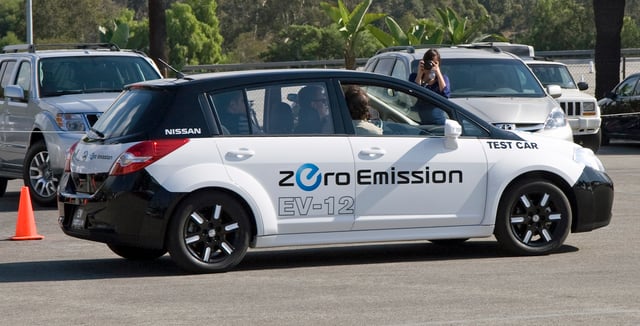
The EV-12 test car was based on the Nissan Tiida/Versa.
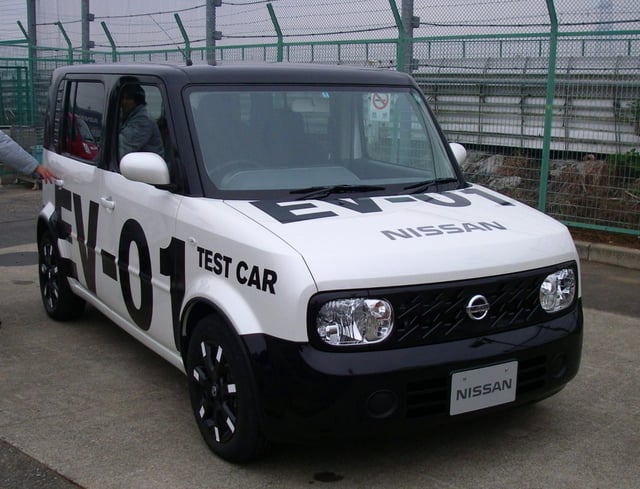
The Nissan Cube-derived EV-01 test car was Nissan's first prototype with the all-electric drive train later used in the Leaf.
Nissan introduced its first battery electric vehicle, the Nissan Altra, at the Los Angeles International Auto Show on 29 December 1997.[4] The Altra was produced between 1998 and 2002. Only about 200 Altras were ever produced, and it was mainly used as a "fleet vehicle" for companies such as electric utilities.[5][6] Nissan also developed the Nissan Hypermini and ran a demonstration program for it. The car sold in limited numbers to supply government and corporate fleets in Japan between 1999 and 2001.[7] A small fleet of Hyperminis was also field-tested in several cities in California between 2001 and 2005.[8] Nissan's electric vehicle development history has been an endeavor going back to 1946, starting with companies Nissan acquired over the years.
In 2009, Nissan unveiled the EV-11 prototype electric car. It was based on the Nissan Tiida (Versa in North America), but with the conventional gasoline engine replaced with an all-electric drivetrain, and included an 80 kW (107 hp)/280 N⋅m (207 lbf⋅ft) electric motor, 24 kWh lithium-ion battery pack rated to have a range of 175 km (109 miles) on the United States Environmental Protection Agency's LA-4 or "city" driving cycle, navigation system, and remote control and monitoring via a cellphone connection through Nissan's secure data center to the car.[9] The technology in the EV-11 was previously developed and tested in the EV-01 and EV-02 test cars, built with an all-electric powertrain that used the Nissan Cube (Z11) as a development mule.[10][11] The EV-11 prototype was on display 26 July 2009.[9] A week later, on 2 August 2009, Nissan unveiled its production version at its Yokohama headquarters and committed to begin retail sales in both the North American market and in Japan at end of 2010.[12][13]
First generation (2010–2017)
Design
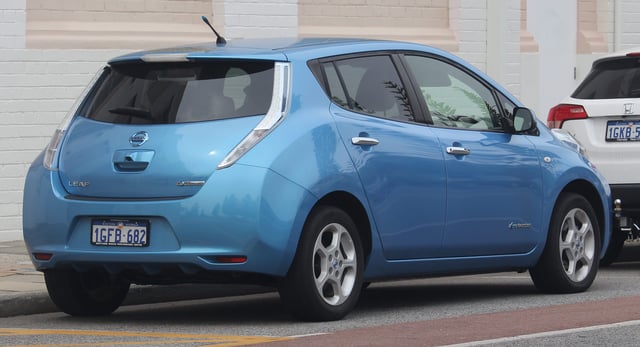
Nissan Leaf SL
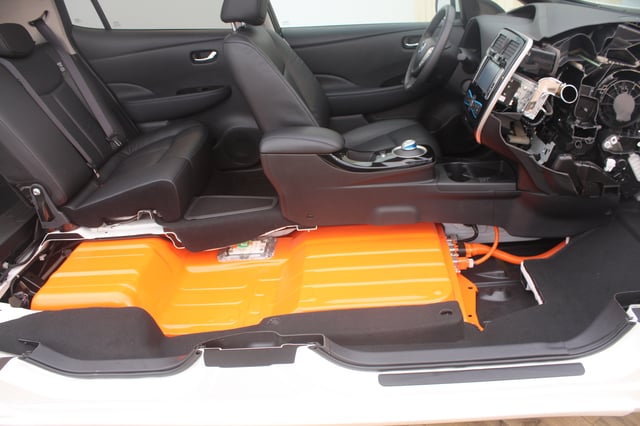
Location of the Leaf lithium-ion battery pack below the seats

Leaf electronic control unit
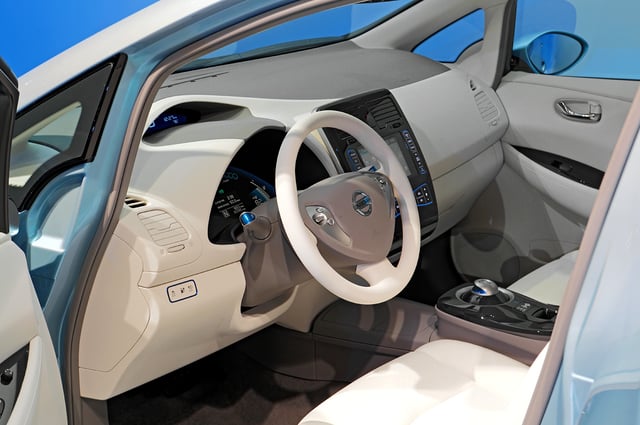
Leaf interior
Nissan sought to make the Leaf appealing to mainstream drivers by giving it a familiar five-door hatchback design.[24] The body has a sharp V-shape design with large, up slanting LED headlights that split and redirect airflow away from the door mirrors, and the bottom of the car has aerodynamic panelling.[25] According to Nissan, the 2011 Leaf has a drag coefficient of C**d=0.29 and the 2013 model year has a drag coefficient C**d=0.28, but Car and Driver magazine measured a 2012 Leaf at C**d=0.32.[26][27] The Leaf's design locates the battery, the heaviest part of any EV, below the seats and rear foot space, keeping the center of gravity as low as possible and giving the car better structural rigidity than a conventional five-door hatchback.[22][28][29]
Powertrain
The Leaf is powered by a synchronous electric motor with 80 kW (107 hp) and 280 N⋅m (207 ft⋅lb) driving the front wheels, with energy supplied by a 24 kWh lithium ion battery pack rated to deliver up to 90 kW (120 hp).[14][30] The 2011/12 model Leaf has a top speed of over 150 km/h (93 mph) and an unofficial 0 to 97 km/h (0 to 60 mph) time of 9.9 seconds.[22]
Battery
In addition to the main battery, the Leaf also has an auxiliary 12-volt lead–acid battery that provides power to the car computer systems and accessories.[37] The small solar panel on the Leaf rear spoiler helps to charge this accessory battery.[38] (In United States models only comes with SL trim.[39])
Battery life and degradation
Nissan said the battery will gradually lose capacity over time, but it expects a useful life of over ten years under normal use.[40] The battery pack is expected to retain 70–80% of its capacity after 10 years but its actual lifespan depends on how often DC fast charging is used, driving patterns, and environmental factors.[34][40] In March 2018, a statistical study compared reported battery decline in 30 kWh Leafs and 24 kWh Leafs, with 30 kWh models exhibiting the same battery capacity as 24 kWh cars within 3.5 years, albeit with probable accelerated battery decline in 30 kWh models.[41] The 2011/12 Leaf's battery was initially guaranteed by Nissan for eight years or 160,000 km (100,000 miles)[42][43] Nissan stated in 2015 that until then only 0.01% of batteries, produced since 2010, had to be replaced because of failures or problems and then only because of externally inflicted damage. Some vehicles have already covered more than 200,000 km (120,000 miles) with no battery problems.[44] In April 2016, Nissan estimated that fewer than 5 batteries are replaced per year worldwide; about 0.012% of all Leafs since introduction.
As a result of the controversy regarding several U.S. owners reporting premature loss of battery capacity in places with hot climate, Nissan USA announced in January 2012, that it will offer an extended battery warranty on the 2013 model year Leaf which includes 2011 and 2012 model years as well.[45] The 2013 Leaf is covered by a "State Of Health" clause which covers gradual capacity loss. This provision allows for the battery pack to either be repaired or replaced if the battery life reduces quicker than anticipated over the eight years warranty period.[46]
- Battery replacement program
Beginning in 2014, Leaf owners could sign up to pay a monthly fee, and receive a new battery pack with the latest available technology that is compatible with their vehicle. The replacement battery has a full 12 bars (100%) of capacity. Nissan said the replacement pack will maintain at least nine bars (70% capacity) or more capacity for the time that they own their car and make monthly payments.[47] Leaf owners could also buy a new battery at a discount.[48]
Range and fuel economy
With an efficient electric powertrain, the Leaf is generally cheaper to operate than traditional gasoline and hybrid cars.[52][53] However, since the Leaf costs significantly more than similar gasoline-powered vehicles, it may take a long time for the fuel savings to cancel out the increased initial cost, even after tax incentives.[54][55][56]
2011/12 model year
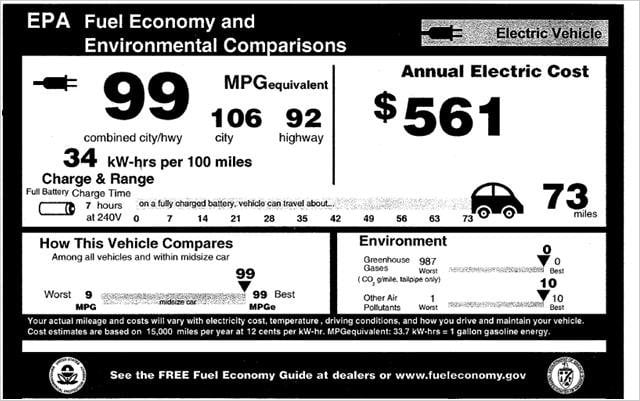
The Monroney label shows the United States Environmental Protection Agency's combined city/highway fuel economy rating of 99 miles per gallon gasoline equivalent for the 2011 Nissan Leaf.[57]
Based on third-party test drives carried out in the U.S., reviewers have found that the range available from a single charge can vary up to 40% in real-world situations; reports vary from about 100 km (62 miles) to almost 222 km (138 miles) depending on driving style, load, traffic conditions, weather (i.e., wind, atmospheric density), and accessory use.[62][63]
Under its five-cycle testing, the US Environmental Protection Agency found the 2011 model Leaf's energy consumption to be 21.2 kWh/100 km (34 kWh/100 miles) and rated the Leaf combined fuel economy at 99 miles per gallon gasoline equivalent – MPGe – (2.4 L/100 km), with an equivalent 106 mpg‑US (2.2 L/100 km; 127 mpg‑imp) in city driving and 92 mpg‑US (2.6 L/100 km; 110 mpg‑imp) on highways.[57][58][64]
2013 model year
According to Nissan, the U.S. 2013 model year Leaf has extended range due to a more efficient heating system, better regenerative braking, weight reduction, and improved aerodynamics.[65][66] The EPA rating is 121 km (75 miles), a slight increase from 117 km (73 miles) in 2011 and 2012 models also due to technicality in the rating system.[17]
Nissan explained that these ratings are not comparable because 2012 and earlier ratings assumed the battery was charged to 100%, but 2013 ratings are an average of the car's two charging modes, Long-Distance Mode, which charges the battery to 100%, and Long-Life Mode, which charges the battery to only 80%. Range in Long-Distance Mode is estimated at 135 km (84 miles).[17][66] The 2013 European version has a certified range of 200 km (120 miles) under the NEDC.[18]
For the 2013 model year Leaf, Nissan achieved a 15% improvement of its EPA's fuel economy combined ratings.[67] According to the EPA, the 2013 Leaf improved its energy consumption to 115 mpg‑e (30 kW⋅h/100 mi; 18.6 kW⋅h/100 km), giving 129 mpg‑e (27 kW⋅h/100 mi; 16.6 kW⋅h/100 km) in city driving and 102 mpg‑e (34 kW⋅h/100 mi; 21 kW⋅h/100 km) on highways.[68]
2014/15 model year
The official EPA range for the 2014 and 2015 model year Leaf, increased from 121 to 135 km (75 to 84 miles).[69] The difference in range is due to a technicality, as Nissan decided to eliminate the EPA blended range rating, which was an average of the 80% charge range and the 100% charge range. For the 2014 model year, only the 100% charge range figure applies.[70]
According to the EPA, the 2014 and 2015 model year Leafs have an energy consumption of 30 kWh/100 miles, for a combined city/highway rating of 114 mpg‑e (30 kW⋅h/100 mi; 18.7 kW⋅h/100 km); 126 MPGe (27.3 kW⋅h/100 mi; 17.0 kW⋅h/100 km) city and 101 MPGe (34.0 kW⋅h/100 mi; 21.2 kW⋅h/100 km) highway.[16]
2016 model year
Nissan added more battery capacity which increased the range of the car on a full charge. For the 2016 model year, a larger 30 kWh battery was included on the US-market SL and SV trims, and the S trim initially kept the smaller 24 kWh battery found in earlier Leafs.[71] However, midway through the 2016 model year, Nissan changed the battery in the base Leaf S model from 24 kWh to 30 kWh.[72]
The 2016 Leaf with the smaller 24 kWh battery has the same ratings and energy consumption as the 2014/15 models, while the trims with the larger 30 kWh has the same energy consumption of 30 kWh/100 miles, but was rated 112 MPGe (30.7 kW⋅h/100 mi; 19.1 kW⋅h/100 km) for combined city/highway; 124 MPGe (27.7 kW⋅h/100 mi; 17.2 kW⋅h/100 km) city and 101 MPGe (34.0 kW⋅h/100 mi; 21.2 kW⋅h/100 km) highway.[16]
Environmental footprint
In February 2014, the Automotive Science Group (ASG) published the result of a study conducted to assess the life-cycle of over 1,300 automobiles across nine categories sold in North America. The study found that among advanced automotive technologies, the Nissan Leaf holds the smallest life-cycle environmental footprint of any model year 2014 automobile available in the North American market with minimum four-person occupancy. The study concluded that the increased environmental impacts of manufacturing the battery electric technology is more than offset with increased environmental performance during operational life. For the assessment, the study used the average electricity mix of the U.S. grid in 2014.[75][76]
In December 2014, Nissan announced that Leaf owners have accumulated together 1 billion kilometers (625 million miles) driven. This amount of electric miles translates into avoiding 180 million kilograms of CO2 emissions by driving an electric car in comparison to travelling with a gasoline-powered car.[77] In December 2016, Nissan reported that Leaf owners worldwide achieved the milestone of 3 billion kilometers (1.9 billion miles) driven collectively through November 2016, saving nearly 500 million kilograms of CO2 emissions.[78]
Recharging
Charging ports vary among models. Before late 2016, the US-market Nissan Leaf S and SV came with a standard SAE J1772 connector for level 1 and 2 charging (120/220 volts AC)[79] while the SL trim line came with an additional CHAdeMO port for DC fast charging.[80][81] Beginning in late 2016, all three models (S, SV, and SL) came equipped with both charging receptacles.[72]
In North America and Japan, using a standard household outlet and the 7.5-meter (25 ft)[86] cable included by Nissan, the Leaf will regain approximately 5 miles of range per hour. This type of charging is ideal for the commuter that can plug into standard outlets at home and at work during the typical 21 hours a day that the typical North American car is parked. It is also useful for emergency charging from any ubiquitous 120-volt outlet just about anywhere in North America.[83]
For models with DC fast charging, a battery pack can be charged from fully discharged to 80% capacity in about 30 minutes.[87] Nissan warns that if fast charging is the primary way of recharging, then the normal and gradual battery capacity loss is about 10% more than regular 220-volt charging over a 10-year period.[34] Other companies make compatible charging stations, and companies and local government have various initiatives to create networks of public charging stations.[83][88]
Technology
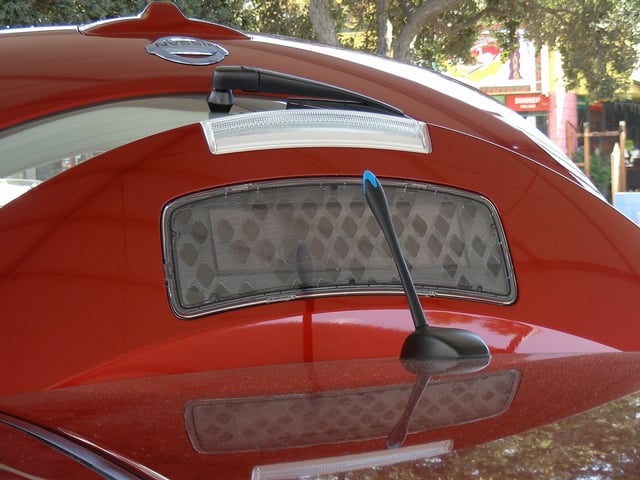
Nissan Leaf SL spoiler-mounted solar panel

Leaf's main dashboard digital display showing driving range (on right) and other performance parameters
The Nissan Leaf employs telematics system called CarWings which originally was only available in Japan.[89][90] The system sends and receives data via a built-in GPRS radio similar to the connectivity of mobile phones. CarWings is connected any time the car is in range of a cell tower and has information such as the car's position, possible range on a map, and which charging stations are available within range, and records statistics about distance travelled and energy consumed. All information is available in the Leaf's digital screens.[89][91]
Safety

2011 Nissan Leaf equipped with warning sound off switch
NHTSA rates the 2011 and 2012 model years as five out of five stars overall. The 2013 and 2014 model years' rating is four stars overall due to lower scores for passengers in front and side tests.[92]
The Nissan Leaf won the "Top Safety Pick" awarded by the Insurance Institute for Highway Safety in 2011. The Leaf received top ratings of "Good" for front, side, and rear impact crash tests, and also on rollover protection. All injury measurements except one were rated good, indicating a low risk of significant injuries in crashes according to the scale of severity employed in the IIHS's testing.[93][94] The European New Car Assessment Programme (Euro NCAP) awarded the Leaf the highest five-star car safety rating, earning the following ratings for each criterion:
| Euro NCAP test results | ||
|---|---|---|
| Nissan Leaf (2011)[95] | ||
| Test | Points | % |
| Overall: | ||
| Adult occupant: | 32 | 89% |
| Child occupant: | 40 | 83% |
| Pedestrian: | 23 | 65% |
| Safety assist: | 6 | 84% |
- Accident and rescue handling
The Nissan Leaf's battery pack is shielded from crash damage by structural steel reinforcement.[99] In December 2011, Nissan reported, as an indication of the Leaf safety performance, that none of the around two dozen Leafs that were destroyed during the March 2011 tsunami caught fire and their batteries remained intact.[100] As of December 2011, no fires after a crash have been reported in the U.S. associated with the Leaf or other plug-in electric cars available in the market.[101]
- Warning sounds
The 2011 Leaf includes digital warning sounds, one for forward motion and another for reverse, to alert pedestrians, the blind, and others of its otherwise silent presence.[102][103] For the 2011 model, the driver could turn off sounds temporarily through a switch inside the vehicle, but the system automatically reset to "On" at the next ignition cycle, but Nissan removed the ability to disable the pedestrian alert between model year 2011 and 2012 in anticipation of the U.S. ruling to be issued by the National Highway Traffic Safety Administration.[104][105][106]
After the new sounds were publicized, the U.S. National Federation of the Blind commented that "while it was pleased that the alert existed, it was unhappy that the driver could turn it off."[103] The Leaf's electric warning sound had to be removed for cars delivered in the UK, as the country's law mandates that any hazard warning sound must be capable of being disabled between 11:00 p.m. and 6:00 a.m., and the Leaf's audible warning system does not allow for such temporary deactivation.[107]
Production
In March 2013 Nissan had an installed capacity to produce 250,000 Leafs per year: 150,000 at Smyrna, Tennessee, 50,000 at Oppama, Japan, and 50,000 at Sunderland, England.[108] The first vehicles sold in the U.S. were produced at Nissan's plant in Oppama, Japan, which started production on 22 October 2010.[36][109] U.S. production began in January 2013, at Nissan's manufacturing facility in Smyrna, Tennessee.[65] Production of the Leaf at Nissan's plant in Sunderland, England, began in March 2013.[110] In March 2013 the Chinese government announced that a partnership between Nissan and Dongfeng Motor to build Leafs was being planned. The production line would be able to produce 10,000 units per year initially, increased to 50,000 units by 2015.[111]
2013 model year
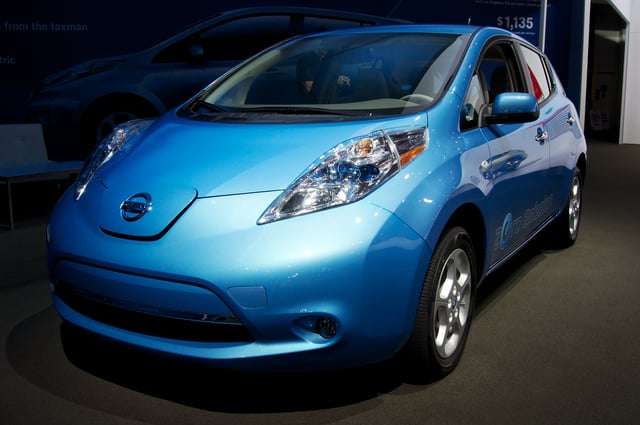
2013 model year Nissan Leaf exhibited at the 2012 Los Angeles Auto Show
- Japanese market
In November 2012, Nissan announced the specifications of the updated 2013 model Leaf destined for the Japanese market. The new version extends range on the Japanese cycle from 200 to 228 km (124 to 142 miles), an increase of 14%. Besides adjusting the regenerative braking to improve power generation, Nissan integrated the electric motor, inverter, and AC/DC converter, used lighter parts throughout, and improved the battery module, achieving a weight reduction of 77 kg (170 lb) or 5%.[112][113]
The 2013 Leaf has a larger trunk, with its volume increased from 330 to 370 litres (11.6 to 13 cu ft). The extra space was freed by moving a downsized charger from the back of the car to the front. Other improvements include a new gauge for the battery's charge in percent, and a long-life battery mode available in any charging mode, which only charges the battery to 80% to improve pack life. Also, Nissan introduced the lower-priced S trim in the Japanese market. This model will be priced at just under ¥2.5 million (around US$29,700), almost half a million yen (approximately US$5,950) cheaper than the previous year's entry price.[112][113]
- American market
The 2013 model year Leaf destined for the U.S. market has several key improvements similar to the Japanese version: better range, faster charging capabilities, a more efficient cabin heater, and a lower starting price. According to Nissan USA, several of the changes aim to address shortcomings in the previous Leaf, and feedback from Leaf owners was taken into consideration.[26][85] The 2013 model year Leaf delivers a higher range than the 2012 model with the same 24 kWh battery pack. The efficiency gains come from a combination of improvements to aerodynamics through tweaks to the front fascia that allowed a reduction of the drag coefficient; a more efficient heater; the addition of a driver-selected B-mode that increases regenerative braking; and energy/range management.[26][85]
The charge port area now comes with a light, and the ability to open the port door from inside the car or by using the key fob.[85] The onboard charger in all 2013 Leafs is more compact and located under the hood, increasing cargo volume.[26] Nissan introduced a new trim level called the Leaf S model with a lower starting price. The S trim has projector beams instead of LED headlights, and 16-inch steel wheels with hubcaps instead of alloy wheels. The base trim does not include the navigation system or the remote connectivity that allows drivers to turn on the climate control and monitor battery charging remotely using a smartphone.[26] LED headlamps, fog lights, 17-inch alloy wheels and leather seating, are reserved for the higher-end SL trim. Additional premium upgrades to the SL trim include a Bose seven-speaker audio system and around view monitor, which puts cameras in front, in back and on the side mirrors for parking assistance.[85]
The new base-level 2013 Nissan Leaf S starts at US$28,800, the mid-level Leaf SV at US$31,820, and the high-end Leaf SL trim starts at US$34,840. All prices have a mandatory US$850 destination fee added.[114]
- European market
The 2013 European version has many of the same improvements of the Japanese and U.S. versions, including an extended range, greater recyclability, more interior space, better charging performance, and more equipment. Also three versions will be available: Visia, Acenta and Tekna. The Visia version has a lower starting price than the previous model, and the Tekna model has even more standard equipment than the 2011/2012 Leaf. The European version was unveiled at the 2013 Geneva Motor Show, and production of the 2013 model began in March 2013 at the Sunderland plant in the UK, and sales started in June 2013.[18] The price of the 2013 Leaf produced in Sunderland is lower than the one built in Japan,[108][115] and to further reduce the purchase price by GB£5,000, Nissan offered a battery leasing option for all trims produced at Sunderland.[116][117] The leasing option is also available in several European countries, reducing the purchase price by €5,900.[118] This measure, among others, helped to reduce the sales price in Germany, for instance, from roughly €37,000 in April 2012[119] (with battery) to roughly €24,000 in July 2013 (excluding battery lease of €79 per month).[120]
2014 model year
- American market
The 2014 model year Leaf went on sale in December 2013 in the U.S. The 2014 Leaf is largely the same as the 2013 model year, except:[121]
RearView Monitor is standard on all trims
Updated EV-IT functionality with voice destination entry and SMS readout
Second generation (2017-present)
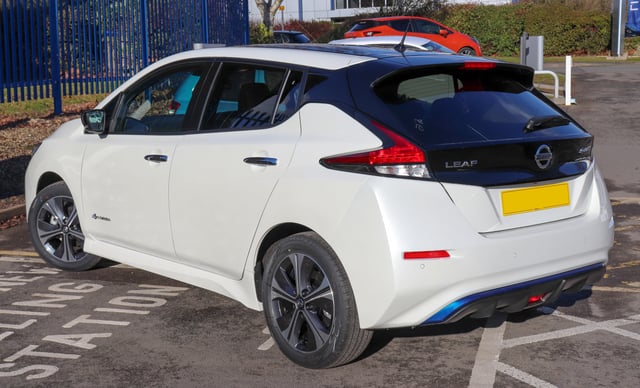
Rear view
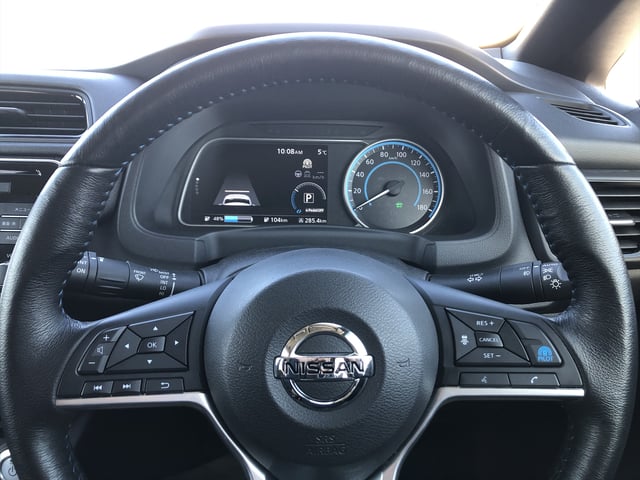
Interior (ProPilot)
The second-generation leaf has a 40 kWh battery pack with an EPA-rated range of 243 km (151 miles)[123] on a single charge. The electric motor produces 110 kilowatts (147 hp) and 320 newton metres (236 lb⋅ft) of torque.[122] It charges through either a 6.6 kW regular plug (SAE J1772 in US/Japan, or a Type 2 connector in EU countries) or a 50 kW CHAdeMO, and has the ability to send power back to the grid.[127] Propilot Assist, a lane centering system, is available on the two highest trim levels for an additional cost, and has automatic parking in some markets.[128]
At CES 2019, Nissan unveiled the Leaf e+ (Leaf Plus in the US), which has a larger 62 kWh battery providing forty percent better range (226 miles versus the regular Leaf 150 miles), and a new 150 kW motor which provides thirty-three percent more power. The Leaf e+ can use CHAdeMO chargers up to 100 kW. Nissan's Intelligent Mobility interface now has a larger eight-inch display, with software updated over the air. Door-to-door navigation, which can sync with smartphones, is also offered along with integrated Nissan energy, a vehicle-to-home system.[129]
Markets and sales

The U.S. is the top-selling Leaf market with 126,747 units delivered by the end of October 2018.[153] Shown a first generation Leaf model.

A Nissan Leaf at a quick-charging station in Latvia.
Nissan officially introduced the Leaf in a ceremony held at its global headquarters in Yokohama on 3 December 2010.[130] The first American customer delivery took place in Northern California on 11 December 2010[131] and the first delivery in Japan took place at the Kanagawa Prefecture on 22 December.[132] Deliveries to individual customers began in Ireland in February 2011, in the UK in March 2011, and in France in August 2011.[133][134][135] Deliveries to corporate customers began in Portugal in December 2010,[136] in the Netherlands in March 2011,[137] and in Canada in July 2011.[138] Retail deliveries began in Spain and Norway in September 2011[139][140] in Switzerland in November 2011,[141] and in Germany in January 2012.[142][143] As of January 2018, the Leaf was available in more than 60 countries in four continents.[144]
Nissan sold 49,117 Leafs worldwide in the two years from its introduction in December 2010, making the Leaf the world's best-selling highway-capable electric car.[145] With global sales of more than 22,000 units in 2011,[146] the Leaf surpassed the Mitsubishi i MiEV as the best-selling all-electric car to date.[147] Global sales during 2012 reached 26,973 Leafs, a rise of 22% over 2011 sales, led by Japan with 11,115 units, an 8% increase over 2011 sales; followed by the United States with 9,819 units representing a 1.5% rise over 2011 sales.[148] During the first half of 2012, the Leaf had a market share of 49% of global sales of all-electric cars.[149] 50,000 units had been delivered worldwide by mid February 2013.[150] A total of 47,716 Leafs were sold during 2013, up 77% from 2012,[151] and making the Leaf the world's best-selling plug-in car in 2013.[152]
As of mid January 2014, after three years in the market, global sales totaled 100,000 units.[154] During 2014 a total of 61,507 Leafs were sold worldwide.[155] In 2014 the Leaf ranked as the world's best-selling plug-in car for the second consecutive year.[152] Global sales totaled over 158,000 units at the end of 2014.[156]
200,000 Leafs had been sold globally by December 2015.[157][158] Total sales totaled 43,651 units worldwide in 2015, down 29% from 2014,[159] and making the Leaf the world's second best-selling plug-in car in 2015 after the Tesla Model S.[152] The leading market in 2015 was the United States with 17,269 units sold, down 42.8% from 2014,[160] followed by the European market with 15,630 units.[159]
Global sales in 2016 climbed to 51,882 units, including the Chinese-assembled rebadge Venucia e30, helping the Leaf to narrowly surpass the Tesla Model S, and rank as the top selling plug-in car in 2016.[161][162] Sales in 2016 were led by Europe with 18,718 units, followed by Japan with 14,793, North America with 15,512.[152] Global Leaf sales passed the 250,000 unit milestone in December 2016,[163] and the 300,000 mark in January 2018, making the Nissan Leaf the world's best-selling highway-capable electric car to date.[144] As of December 2016, the United States ranked as the top-selling market, with 103,597 units delivered,[164][165] followed by Japan with 72,494,[166] and Europe with 67,829 units.[152][155][159] The leading European market was Norway, with 19,407 new units registered up until December 2016.[164][167] Due to the significant number of used imports registered in the country, there were about 27,500 Leafs on Norwegian roads as of 31 December 2016.[167][168] The UK ranked second with 15,000 units sold by mid-September 2016.[169]
Global sales in 2017 fell to about 47,000 units, in anticipation of the second generation.[170] When the latter reached the market in 2018, global Leaf sales reached a record level of 87,149 units, third behind the Tesla Model 3 and the BAIC EC-Series.[171]
- Battery leasing option
Initially the Leaf was sold in all markets including the battery pack, and is not compatible with QuickDrop battery swapping developed by its alliance partner Renault.[172][173] In April 2013, Nissan announced that sales of the 2013 Leaf would begin in the UK in June 2013, and that it would offer a battery leasing option for the three available trims. Pricing for the battery leasing in the UK started at GB£70 (~US$108) per month for a 36-month lease limited to not more than 12,100 km (7,500 miles) a year, with a maximum of GB£129 (~US$198) per month for a 12-month lease with no more than 24,000 km (15,000 miles) driven. The battery leasing option lowers the price of the entry-level model to GB£20,990 (~US$32,230) before applying the Plug-in Car Grant.[116][117]
In several European countries, except Norway, Finland, Iceland, Ireland and the Baltic states, the leasing option was also to be offered, reducing the purchase price by €5,900. The battery is priced at €79 (~US$103) monthly for a 36-month lease limited no more than 12,500 km (7,800 miles) a year, with a maximum of €142 (~US$186) per month for a 12-month lease with no more than 25,000 km (16,000 miles) driven.[118]
Global sales
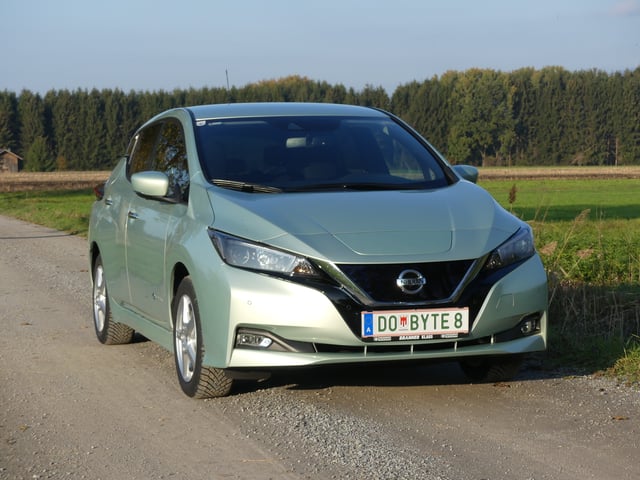
The Nissan Leaf is the world's best-selling all-electric car in history, with global sales of over 400,000 units by March 2019.[3]
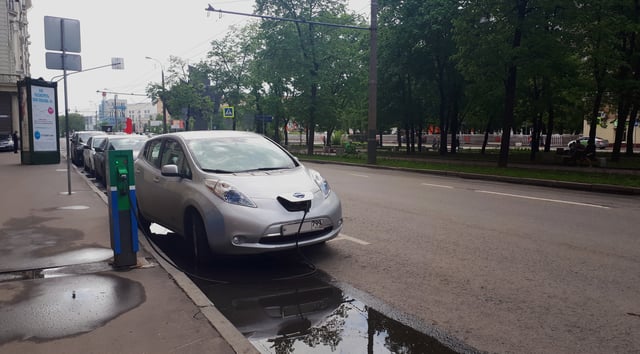
Nissan Leaf in Moscow.
Since its introduction in 2010, more than 400,000 units have been sold worldwide by March 2019, making the Leaf the world best-selling highway-capable electric car to date.[3] As of October 2018, the United States ranks as the top-selling market with 126,747 units,[153] followed by Japan with 100,000 units delivered by April 2018,[174] and Europe with 100,000 units by June 2018.[175] The European market is led by Norway with 33,156 new Leafs registered up until October 2018,[164][167][176][177] but due to the significant number of used imports registered in the country, there were 48,235 Leafs on Norwegian roads as of 31 October 2018, representing over 25% of total all-electric car registrations in Norway.[178] Ranking second is the UK with over 25,000 units sold by early June 2018,[179] but due to used exports to neighboring countries, only 22,919 were registered at the end of June 2018.[180]
The following table presents retail sales by year since deliveries of the Leaf began in December 2010, for the national markets with cumulative sales of more than 500 units through the end of 2017.
| Country | Total | 2017 | 2016 | 2015 | 2014 | 2013 | 2012 | 2011 | 2010 |
|---|---|---|---|---|---|---|---|---|---|
| US[160][181][182][183][184] | 114,827 | 11,230 | 14,006 | 17,269 | 30,200 | 22,610 | 9,819 | 9,674 | 19 |
| Japan[152][155][185][186][187] | 96,999 | 16,925 | 14,793 | 9,057 | 14,177 | 13,021 | 11,115 | 10,310 | 19 |
| Norway[176][188][189][190][191] | 22,781 | 3,374 | 4,162 | 3,189 | 4,781 | 4,604 | 2,298 | 373 | |
| UK[192][193][194][195] | 22,359 | 5,463 | 4,463 | 5,236 | 4,051 | 1,812 | 699 | 635 | |
| France[196] | 12,113 | 2,381 | 3,887 | 2,200 | 1,600 | 1,438 | 524 | 83 | |
| Canada[197] | 5,519 | 946 | 1,375 | 1,233 | 1,085 | 470 | 240 | 170 | |
| Germany[198][199][200][201] | 4,918 | 841 | 1,121 | 831 | 812 | 855 | 451 | 7 | |
| China[202][203] | 4,032[1] | 1,961 | 1,273 | 582 | 216 | ||||
| Netherlands[204][205][206][207] | 3,157 | 513 | 666 | 447 | 510 | 462 | 265 | 294 | |
| Sweden[208][209][210][211] | 3,542 | 981 | 836 | 841 | 438 | 317 | 129 | ||
| Spain[212][213][214][215][216] | 2,159 | 530 | 344 | 344 | 465 | 263 | 154 | 59 | |
| Italy[217][218][219][220][221] | 2,103 | 448 | 460 | 389 | 332 | 323 | 146 | 5 | |
| Denmark[222] | 1,202 | 20 | 85 | 224 | 577 | 211 | 73 | 12 | |
| Ireland[223][224][225][226][227] | 1,366 | 258 | 352 | 405 | 192 | 43 | 69 | 45 | 2 |
| Belgium[228][229][230][231][232] | 1,510 | 389 | 466 | 162 | 178 | 141 | 114 | 60 | |
| Austria[233] | 1,151 | 384 | 333 | 156 | 121 | 88 | 64 | 3 | |
| Australia[234][235][236][237] | 997[2] | 384 | 156 | 109[2] | 173 | 188 | 77 | 19 | |
| Switzerland[238] | 831 | 131 | 158 | 145 | 106 | 178 | 74 | 39 | |
| Total top markets | 293,545 | 44,814 | 49,624 | 43,354 | 60,259 | 47,152 | 26,247 | 21,785 | 40 |
| Total global sales[146][148][151][155][156][159][152][170] | 303,678 | ~47,000 | 49,245 | 43,651 | 61,507 | 47,716 | 26,973 | 22,094 | 50 |
Reported problems
- Initial problems
In April 2011, Nissan announced that customers in the United States and Japan reported problems in restarting their Leaf vehicles after switching the motor off. Nissan said the problem does not pose any accident risk.[239] On 15 April. Nissan announced that the problem only affected a small proportion of Leafs. Nissan engineers identified a programming error in an air conditioning system sensor that sometimes triggers an erroneous high voltage alert when the air conditioning unit is switched on, due to the increased demand for power. The system issues an Inhibit Restart command, which does not prevent driving the vehicle, but does prevent it restarting after it is turned off. The solution requires reprogramming of the Vehicle Control Module by a Nissan dealer. Nissan announced a "service campaign" to apply the software fix to all 5,300 Nissan Leafs in operation around the world, but it was not an official recall because it was not a safety problem.[240][241][242] The applied software update also improves the car's on-board range calculation system, which several Leaf owners reported was overestimating the number of miles left. In addition, the update changes the state-of-charge bars display to provide a true reserve capacity; the driver now has up to five miles to find a charging spot after the car reaches the zero miles remaining mark.[243]
- Battery capacity loss
In May 2012, several U.S. owners reported seeing only 11 of 12 battery capacity bars on the in-car display which led them to believe they had lost some battery capacity. As time went on, more people reported seeing the problem, and some had lost two, three, and even in rare cases, four battery capacity bars. The battery capacity loss problem seems to be concentrated in regions with a hot climate, and Phoenix, Arizona and the state of Texas in particular. In July 2012, Nissan responded by saying they were investigating the problem, and a carmaker spokesman also said that "the problem is isolated to maybe 0.3% of the 13,000 Leafs on U.S. roads," the company reportedly has loaned cars to some Leaf owners in Arizona as it researches the issue. This is equivalent to around 40 vehicles that have experienced a loss of any battery capacity bars.[244][245]
By early September 2012, a Nissan Executive Vice President said that there is "no problem with the Leaf battery, and that any customer complaints were merely the result of instrument problems."[246] As a response, a group of 12 Phoenix Leaf owners participated in an independent test in controlled conditions organized by Leaf driver and EV advocate Tony Williams that took place on 15 September 2012. The test confirmed that the Leaf has poor instruments, but the test also found significant loss of range in some cars reflecting battery capacity loss. The worst affected Leaf showed around 60 to 65% of its original battery capacity remaining, and was only capable of driving 95 km (59 miles) before running out of charge.[246][247][248]
Based on a complete evaluation that Nissan Americas conducted with seven different Leafs in its Arizona Testing Center, the carmaker found that the common link among the seven Leafs from Arizona was that all of them had covered much higher mileage than the 20,100 km (12,500 miles) Nissan used to estimate the rate of battery capacity loss over time. All of them had covered at least 50% more than the Nissan estimated average, with 31,500 km (19,600 miles) as the average mileage for the cars evaluated. According to Nissan, that average is "more than double the average Phoenix customer mileage of 7,500 miles per year." Nissan concluded that "the cars and the battery packs are behaving as we expected."[249][250] As a result of this assessment, Nissan published an open letter to Leaf owners explaining the results of the assessment and the details of normal battery capacity loss expected over time. The company also decided to set up an independent advisory board to study how the company may improve its communication with customers about the performance of the Leaf. The group will be led by Chelsea Sexton, known for her prominent role in the marketing of the GM EV-1 electric car. She will select the members of the advisory board that would make recommendations to Nissan.[250] By late September Nissan reported that around 450 Leafs have been sold in Arizona, and in the interest of customer satisfaction, two units with battery loss problems were repurchased using the buyback formula modeled on Arizona's lemon law.[251][252] One of the owners that had their Nissan Leaf repurchased established a blog in order to persuade other potential Nissan Leaf buyers in hot climates to reconsider buying this particular vehicle.[253] By mid September, Nissan's CEO Carlos Ghosn announced that there is an improved second generation battery coming online that will cost less than the previous one.[254]
In January 2013, Nissan USA announced that it will offer an extended battery warranty on the 2013 model year Leaf and will include 2011 and 2012 model years as well.[45]
A 2015 report by insurance company Warranty Direct, stated that of 35,000 Leafs sold in Europe, three had a battery failure. That is 0.01% cars immobilized compared to 0.255% for internal combustion engined cars.[255]
On 24 September 2012, a Class Action Complaint against Defendants Nissan Motor Company Ltd, Nissan North America Inc., was filed by California Plaintiff Humberto Daniel Klee and Arizona Plaintiff David Wallak. The class action stated “Before purchase or lease, Nissan failed to disclose its own recommendations that owners avoid charging the battery beyond 80% in order to mitigate battery damage and failed to disclose that Nissan’s estimated 100 mile range was based on a full charge battery, which is contrary to Nissan’s own recommendation for battery charging.” It accused Nissan of concealing that its Leaf vehicles had a design defect that causes them to prematurely lose battery life and driving range, charging Nissan with violations of California's Consumer Legal Remedies Act, Arizona's Consumer Fraud Act and Unfair Business Act, negligent misrepresentation, and breach of Implied Warranty under the Song-Beverly Consumer Warranty Act. On 7 July 2015, U.S. Circuit Judge A. Wallace Tashima of the 9th Circuit U.S. approved the class action settlement in the U.S. District Court for the Central District of California, valued at $24 million.[256]
In March 2018, a study in New Zealand showed accelerated reported battery decline in 30 kWh Leafs compared to 24 kWh Leafs.[41] In response to this problem, Nissan issued a software fix, on 6 June 2018 in the USA [257] and somewhat later in New Zealand.[258] Consumer NZ advises affected owners to "go back to the dealer who sold the car (also likely to be the importer) and ask it to pay for the software update. You can also claim any reasonable costs you incur to get your car repaired."[259]
Related cars
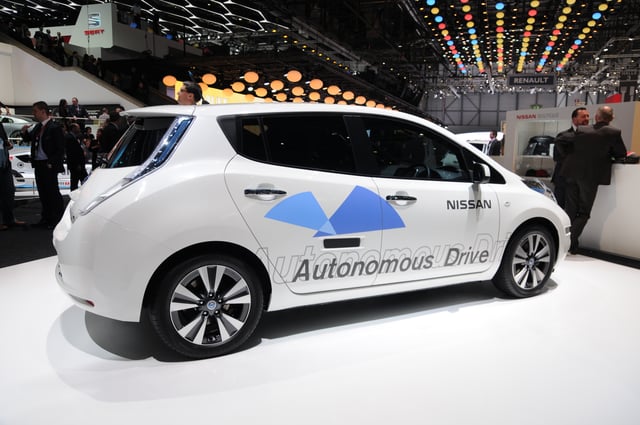
Nissan installed its autonomous car technology in a Nissan Leaf for demonstration purposes
- Leaf Aero Style
- Leaf Nismo
Nissan unveiled the Leaf Nismo RC (Racing Competition) demonstration car at the 2011 New York International Auto Show. This electric car has the same battery pack and motor as the Leaf but is designed and constructed as a racing car with a full carbon fiber monocoque body which makes it about 40% lighter than the production Leaf.[262] Leaf Nismo RC is projected to have a running time of around 20 minutes under racing conditions, and in preliminary testing it accelerated from 0 to 62 mph (0 to 100 km/h) in 6.85 seconds and has a top speed of 93 mph (150 km/h).[263][264] Nissan built eight of these rear-wheel drive cars.[262]
Another concept from Nismo was unveiled at the 2011 Tokyo Motor Show, the Leaf Nismo Concept. It was designed as normal highway-capable automobile and uses the same 80 kW electric motor as the Leaf.[265] In January 2013, Nissan announced that the Leaf Nismo will be produced in low volumes by mid-2013, and sold in Japan only. The Leaf Nismo uses the Leaf's all-electric drive train with no extra power or performance improvements, but has an aerodynamic body kit with styling influenced by the electric Leaf RC demonstrator, new alloy wheels, and interior improvements.[266]
- Infiniti LE
The Nissan Infiniti LE concept all-electric car was unveiled at the 2012 New York International Auto Show. It is based on the same platform as the Leaf, but it is expected to become Nissan's luxury electric car. It was expected to go into production in 2014.[267] In May 2013 the company said that it was waiting for inductive charging industry standards before launching the vehicle.[268][269]
- Venucia e30
Nissan and its joint venture partner Dongfeng Motor unveiled a production version of the Venucia e30 electric car at the 2012 Auto Guangzhou. An earlier version, the Venucia E-Concept, was unveiled at the 2012 Beijing Auto Show. The car was initially scheduled for production in China by 2015. The Venucia e30 shares the bodywork, dimensions, electric-drive specifications and several other aspects of the Leaf. Dongfeng Nissan started pilot projects in 15 Chinese cities to promote the Venucia e30 with local governments.[270][271] A total of 216 units were delivered in December 2013. These units were marketed as Venucia Morning Wind and they were badged Leafs since local production had not begun at the time.[202] In April 2014 Dongfeng Nissan announced that retail sales of the Venucia e30 were going to begin ahead of schedule.[272]
- Autonomous car
In August 2013, Nissan announced its plans to launch several driverless cars by 2020. The company is building in Japan a dedicated autonomous driving proving ground, to be completed in 2014. Nissan installed its autonomous car technology in a Nissan Leaf for demonstration purposes. The car was demonstrated at the Nissan 360 test drive event held in California in August 2013.[275][276] In September 2013, the Leaf fitted with the prototype Advanced Driver Assistance System was granted a license plate that allows it to drive on Japanese public roads. The test car will be used by Nissan engineers to evaluate how its in-house autonomous driving software performs in the real-world. Time spent on public roads will help refine the car's software for fully automated driving.[277] The autonomous Leaf was demonstrated on public roads for the first time at a media event held in Japan in November 2013. The Leaf drove on the Sagami Expressway in Kanagawa prefecture, near Tokyo. Nissan vice chairman Toshiyuki Shiga and the prefecture's Governor, Yuji Kuroiwa, rode in the car during the test.[278][279]
Motorsport

Leaf Nismo RC (ZE1)
An Electric Production Class was formed for the 2011 Pikes Peak International Hill Climb and Chad Hord raced a Leaf in the event.[280] The off-road racing driver ascended the 19.99 km (12.42 miles) course in 14 minutes and 33 seconds to win the class.[281] The interior of the car was removed and replaced with mandatory racing seats, safety harness, and a roll cage.[282]
Reception
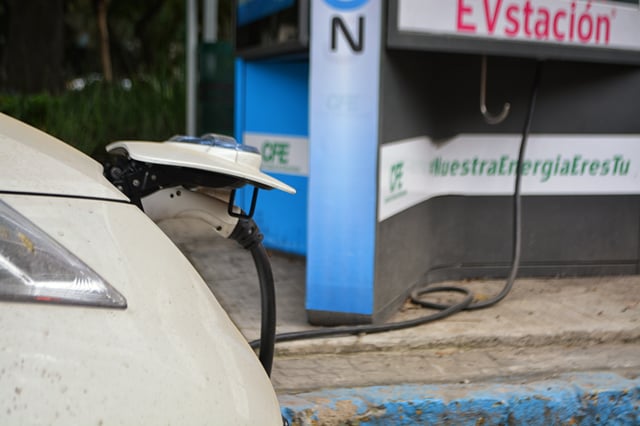
Nissan Leaf charging at a public station in Mexico City
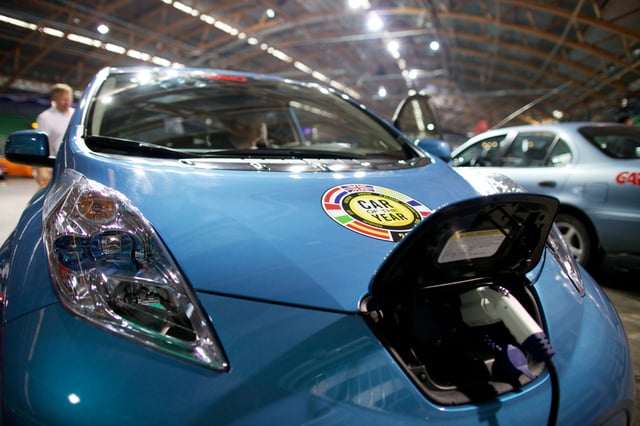
Nissan Leaf with the 2011 European Car of the Year logo
There were 20,000 pre-orders in the United States for the vehicle's debut.[283] After hitting this milestone in September 2010, Nissan stopped taking reservations in the United States until many of the initial orders had been delivered in early 2011.
Awards
The Leaf has received awards from multiple organizations. Notable awards include the inclusion by Time magazine as one of the 50 best inventions of 2009.[284] At the 2010 Washington Auto Show, the Leaf was given the 2010 Green Car Vision Award by the Green Car Journal, which said that the Leaf "will provide the features, the styling, and the driving experience that will meet the needs of a sophisticated and demanding market, while producing zero localized emissions and requiring no petroleum fuels."[285] Popular Mechanics, upon awarding the Leaf its 2010 Breakthrough Award, explained that the Nissan Leaf is "not the first pure EV, but [...] hits the mainstream like none of its predecessors." Popular Mechanics also alluded to the Leaf's 160 km (100 miles) range, which is said to be "enough for most commuters for the price of an average vehicle – and with a much lower operating cost than gasoline-powered vehicles."[286]
Other awards received by the Leaf include the 2011 European Car of the Year,[287] EV.com's 2011 EV of the Year,[288] 2011 Eco-Friendly Car of the Year by Cars.com,[289] 2011 Green Fleet Electric Vehicle of the Year,[290] it was listed among the 2011 Greenest Vehicles of the Year by the American Council for an Energy-Efficient Economy,[291][292] also listed by Mother Earth News among its "Best Green Cars" of 2011,[293] and also was ranked first in Kelley Blue Book Top 10 Green Cars for 2011.[294] The Leaf won the 2011 World Car of the Year,[295] and was a finalist for the 2011 World Green Car.[296] Ward's Auto listed the Leaf's 80 kW electric motor in Ward's 10 Best Engines for 2011.[297] Until October 2011 the Leaf was ranked as the most efficient EPA certified vehicle for all fuels ever.[298][299] In December 2011, the Leaf was awarded with the 2011–2012 Car of the Year Japan at the Tokyo Motor Show.[300]
Criticism

Nissan Leaf with Level 2 recharging station unit displayed at the 2010 Washington Auto Show
In 2009, a former Tesla Motors marketing manager criticized Nissan for the lack of effective thermal management system of lithium-ion battery packs.[301] He also said there may be an overestimation of the 160 km (100-mile) range that was computed using LA-4 or "city" mode, which may underestimate the energy draw during highway driving conditions.[301][302]
The American magazine Consumer Reports noted that while charger costs vary between US$700 and US$1,200, an at-home charger and its installation cost more than US$2,000 even for simple installations.[303] Nissan estimates a typical charger installation costs US$2,200. The article did not mention that home charger installations were eligible for a 50% federal tax credit up to US$2,000.[304] Consumer Reports noted that the first 5,700 Leaf buyers could get free chargers with federal support in 13 cities. The consumer group also reminded that many older houses could require upgrading the electric service panel to install a 240-volt circuit, which can cost several thousand dollars.[303] The additional 220–240-volt charger is required in the countries—mainly in the Americas—that do not have a 220–240-volt domestic grid, if an owner wants faster charging than under 110–120-volt.
There are a variety of EVSE manufacturers for the Nissan Leaf including SPX, Schneider, Leviton, Aerovironment, Blink and GE. Some are priced at less than $850. Since the on-board charger in the Leaf can draw as little as 15 amps, many home installations can be as simple as adding a dedicated 20 amp circuit and receptacle in the garage.
Consumer Reports also called buyers' attention to the fact that the Leaf's total out-of-pocket costs include a US$595 acquisition fee and a US$395 disposition fee. The consumer group also emphasized that the lease price of US$349-a-month applies only to buyers with good credit (Tier 1, or a FICO score of 700 or above); for those with less than optimum credit, the monthly rate would increase. They reminded buyers that the lease comes with a 23,000 km/year (15,000-mile-per-year) allowance, but additional miles will cost extra.[305]
See also
Electric car use by country
EV Project
List of best-selling automobiles
List of electric cars currently available
List of modern production plug-in electric vehicles
List of Nissan vehicles
List of production battery electric vehicles
Nissan electric vehicles
Plug-in electric vehicle
Renault Z.E., from Nissan-Renault Group
Revenge of the Electric Car
Zero-emissions vehicle
